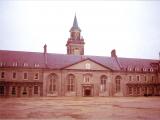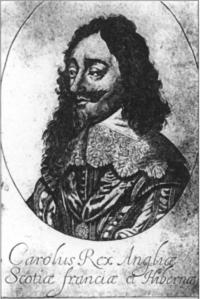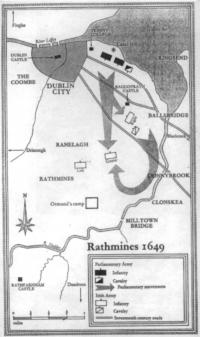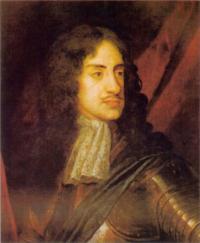Most Illustrious Cavalier’ or ‘U nkinde Desertor’? James Butler, First Duke of Ormond 1610-1688 by Billy Kelly
Published in 1641 Rebellion, Confederate War and Cromwell, Cromwell, Early Modern History (1500–1700), Features, Issue 2 (Summer 1993), Volume 1Even today, over three hundred years since the death of the Duke of Ormond in 1688, the legacy of his viceroyalty is magnificently apparent in the capital city of Ireland. The Royal Hospital at Kilmainham, built in 1677 on Ormond’s orders, was constructed to house the pensioners of the long Irish wars. St Stephen’s Green, laid out in 1663, was the focal point of those residential developments on which the elegance of Georgian Dublin later arose. That Dublin can now boast one of Europe’s great urban parks was also due to Ormond’s influence with Charles II. In an excess of romantic benevolence, the king had bestowed the lands on which the Phoenix Park now stands as a gift on a favourite mistress, the Duchess of Cleveland, and it was partly through Ormond’s determined efforts that the grant was revoked.He was three times Lord Lieutenant of Ireland in a career spanning almost fifty years, when the political and social structures of the kingdom were fundamentally altered. As a result of this long career in the service of the crown, and because of his monumental biography by Thomas Carte, his name has become synonymous with Royalism and with those aristocratic values and virtues which posterity, unhistorically and unfairly, held to be especially inherent in the cavaliers. Indeed for Macaulay, Ormond was ‘the most illustrious cavalier.
‘The Butler Earls
James Butler was born at Clerkenwell in London on 19 October 1610. The Butler earls were among the last of the great Norman lords of Ireland and owned vast estates in Munster and Leinster. Uniquely in the Stuart dominions, the Earls of Ormond retained the palatinate lordship of Tipperary, where they ruled ‘as the king’. Their great power was anathema to the New English administration in Dublin Castle. Moreover,James Butler’s grandfather, the eleventh earl, was a staunch Catholic, nicknamed ‘Walter of the Beads and Rosaries’, and a former leader of Old English opposition in the Irish House of Commons. Therefore Dublin Castle was on the lookout for ways to weaken the Butlers and certain officials in concert with James I’s confidant, the Duke of Buckingham, suggested to the king the possibility of rewarding a Scots favourite, Lord Dingwall, by giving him the hand of the widowed daughter of the tenth Earl of Ormond. The marriage resulted in Dingwall, raised to the Irish peerage as Earl of Desmond, petitioning the king for a grant of the Butler lands in virtue of his wife’s claims as heir-general to the estates of her father. A lengthy litigation ensued in which the odds were very much against the Earl of Ormond. Eventually, in 1619, he agreed to the personal arbitration of the king in the matter and to accept his judgement, on pain of a heavy financial penalty. In the end half the family lands, including the Butler stronghold of Kilkenny castle, was lost, the palatinate jurisdiction of Tipperary was reclaimed by the crown and the old earl was imprisoned in the Fleet for non-payment of his fine.
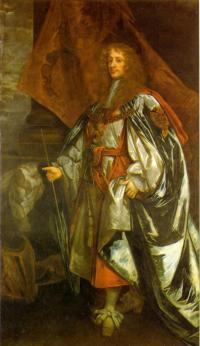
Portrait of lames Butler, First Duke of Ormonde, 1610-1688, by Peter Lely, 1618 -1680. (COURTESY OF NATIONAL GALLERY OF IRELAND)
In the king’s care
For the young James Butler, these events were to have momentous consequences which influenced the course of his life. His father had been drowned off Skerries some months before Earl Walter was imprisoned. On his death, the young James became Viscount Thurles and heir to the lordship of Ormond. In 1620 his mother, a devout Catholic like the rest of the Butler family, placed her son in the care of one Conyers at Finchley, to be educated in that religion. However, part of James I’s policy of furthering the Reformation in Ireland had been to ensure that noble heirs were raised in the Protestant religion, as wards of court, and it was decided that James Butler should be so educated even though he held no lands in tenure rendering him liable to wardship. Legally or otherwise, a masterly sleight of the forensic hand by Sir William Parsons, Master of the Rolls in Ireland, delivered him into the king’s care. Accordingly he was removed from Finchley to be educated by Abbot, the archbishop of Canterbury. It can hardly have been a happy time for Viscount Thurles, living in penury at Lambeth Palace, but his education was certainly a theological if not a scholarly success. For the remainder of his life, James Butler never deviated from his new religion. Parsons, whose legal expertise had enabled the crown to gain the wardship, was often to congratulate himself on the service he had done by giving Ireland a Protestant Earl of Ormond.In February 1633, James Butler became the twelfth Earl of Ormond on the death of his grandfather. Four years before, he had reunited the lordship by his marriage to the Earl of Desmond’s daughter, lady Elizabeth Preston. The marriage was the culmination of years of negotiation begun when the couple were still children. This match had been fraught with difficulties, not the least of which was the Earl of Desmond’s dissatisfaction with the terms, the Duke of Buckingham’s continued interest and, thereby, the king’s disapproval. It is an early indication of that tenacity of purpose, which later served him so well, that James Butler, even in his teenage years, refused to be deterred by these powerful opponents and wooed his intended at court in London. The way was smoothed in August 1628 by the assassination of Buckingham and the death of lady Elizabeth’s parents before the end of the year. The cost of this settlement (the payment of the enormous sum of £15,000 to the Earl of Holland for lady Elizabeth’s wardship for example) encumbered the estate with debt for many years in the future, and Ormond was dogged by financial troubles throughout his life. The strategic marriage was consolidated by affection. Apart from the great estate which formed part of his wife’s dowry, the couple were devoted to each other for over fifty years.
Wentworth
Within ten years of this inauspicious beginning, the young Earl of Ormond rose from virtual obscurity to become the leading royalist in Ireland. This remarkable political ascent was assisted in no small part by the arrival in Ireland in 1633 of Thomas Wentworth, later Earl of Strafford, as Lord Deputy. Indeed, Ormond was one of the few men whom he befriended rather than offended during his tenure of office. There is no doubt that initially at least their relationship was based on political expediency: Wentworth needed the prestige provided by association with the prime nobleman of the kingdom and valued the political influence of the earl; Ormond recognised that Wentworth could provide powerful patronage at the court of Charles I. Ormond proved a trusted assistant in the work of government, especially in the proposed plantation of Tipperary, a project very close to Wentworth’s heart and an integral part of his policy in Ireland. Over the years, he reaped the rewards of collaboration: he was made a Privy Councillor in 1635 and lieutenant general of horse in the new Irish army raised in 1638. Most of all, co-operation with Wentworth provided Ormond with friends at court and gained the ear of a grateful Charles I. During the 1630s a genuine friendship developed between the earl and the Lord Deputy. On the eve of his execution in May 1641, Strafford recommended to the king that his garter, one of the highest honours attainable, be bestowed· on the Earl of Ormond. Ormond’s refusal of the honour, ostensibly on the grounds that toe king might use it to win someone to his cause, has been heralded by his biographers as an instance of his selfless loyalty. It may on the other hand have been a case of political sagacity and pragmatism. Shortly after this, he petitioned the king for the regrant of the palatinate of Tipperary, a more tangible and enduring, if less honorific, mark of royal favour.
Rebellion and civil war
The turmoil of the years which followed cast Ormond into the forefront of political affairs in all three kingdoms. As the crisis of the Stuart monarchy deepened, the Earl of Ormond’s advancement to high office Engraved portrait of King Charles I. accelerated. Ormond was only thirtyone years of age at the outbreak of the rebellion in Ireland when the king entreated him to resume his post of lieutenant general of his forces there. Although the great majority of Ormond’s family, friends and tenants joined the Irish Confederacy, he showed no reluctance in performing his duties as commander of the king’s forces and defeated them on a number of occasions. Indeed, even after the beginning of civil war in England in August 1642, Ormond was feted by both Charles I and a party in the English parliament, in the hope of gaining his allegiance. After defeating the Confederate forces at Kilrush in April 1642, he was voted an expensive jewel by the English House of Commons. In the month civil war broke out in England,
Charles I made him Marquis of Ormond as a public mark of his favour (and, the Venetian ambassador alleged, to retain his loyalty). This honour was much enhanced, and Ormond made considerably wealthier, by royal assent to his petition that all those lands held by his relations in Kilkenny which reverted to the king on their rebellion might be given to him. Although opportunism rather than selfless loyalty would seem to have been the guiding principle here, Ormond remained a royalist throughout the war. He kept the army loyal to the king in the face of bribery and subversion by commissioners of the English parliament and their sympathisers in the Irish government. During the next decade of desultory warfare in Ireland, Ormond continued in this command, almost always denied the means of prosecuting the war to a conclusion by a king who had not the wherewithal to give them, and an English parliament whose main concern was to prolong the fighting there, to deny the king the assistance Ireland might provide in his war against them. As Charles I’s military situation deteriorated, he determined to bring over an army from Ireland to his aid and ordered Ormond to make peace with the Irish Confederates. The marquis seemed ideally placed to represent the king in these negotiations since a large part of the Confederate forces were officered by members of his immediate family. The Confederate Assembly and Supreme Council included so many of his relatives and friends that their party was known, disparagingly, as the ‘Ormondists’ by their opponents. However, Ormond was personally detested by the papal nuncio, Rinuccini, whose party distrusted Ormond and opposed a settlement with him, mainly on the grounds of his refusal to compromise on the religious issues at stake. Ormond’s reservations on this score have generated lengthy debate and it seems certain that at one stage, in 1645, the increasingly desperate Charles I tried to circumvent him by sending the Catholic Earl of Glamorgan to represent his terms in person to the nuncio. Although a cessation of arms was eventually agreed in September 1643, and Ormond was appointed Lord Lieutenant of Ireland shortly after, negotiations and intermittent warfare dragged on until the Ormond Peace of 1646, by which time it was too late to assist Charles I who was a prisoner of the Scots.
Preferred Protestant rebels to Catholic rebels
The shaky peace of 1646 soon collapsed and Confederate armies advanced on Dublin. Only the lateness of the season and divisions amongst the Confederates prevented the capture of the capital as Ormond was without supplies and would have been unable to withstand a siege of any length. Fearing he would soon be forced to surrender to the Irish, he entered into negotiation with the English parliament and handed Dublin over to their forces on the grounds that he preferred to give up the city to Protestant rather than Catholic rebels. Although his action was later endorsed by the king, it was alleged by the Irish that his negotiations with the parliamentary commissioners were facilitated by his receipt of a bribe of £3,000. The earl’s defenders have always held that this money was to meet the demands of creditors for debts incurred on behalf of the king. Ormond always maintained that his loyalty to the king had ruined him financially. As he prepared to leave Dublin to join the king in July 1647, Ormond reputedly expressed the hope ‘that he was destined to return to Ireland in such force as to efface the shame of leaving it a beggar.’ Indeed, all hope was not yet lost. When the Scots declared for Charles I and initiated the second civil war, Ormond returned to Ireland in September 1648 to rally the anti-parliamentarian forces in the king’s name. The great shock occasioned by the execution of the king in January • . – 1649 and the uncompromising attitude of the parliament towards the Confederates was an enormous fillip to the work. The Confederates had always maintained that they were loyal subjects of the ·king and they readily joined with Ormond to resist a common enemy. Hampered by a lack of funds and supplies as always, Ormond nevertheless invested Dublin but was quickly routed at Rathmines in August 1649 by the parliamentarian commander, Colonel Jones, amid rumours of treachery by supporters of the papal nuncio. The way was thus cleared for the arrival of Cromwell with a well equipped and well paid army two weeks later. Ormond tried in vain to rally his scattered forces but one by one the royalist strongholds fell to parliament.
The Restoration
Leaving Ireland in 1650, he spent the next ten years on the continent in exile with the young Charles II until the Restoration. During this time he became, with his friend the Earl of Clarendon, a trusted advisor to the king. At the Restoration, he was creat- – — ed Duke of Ormond and returned to Ireland two years later as Lord Lieutenant. His most pressing concern was the implementation of the Act of Settlement by which those who had a claim on Irish land were to be satisfied. Not the least of these were the Irish themselves, and many of Ormond’s own family, the great majority of whom had been dispossessed by the Cromwellian conquest. Those who had subscribed loans to the parliament on the outbreak of the 1641 rebellion and those soldiers who were promised lands in lieu of pay now lobbied for their respective claims at court. So great were the claims being made that an exasperated Ormond declared that ‘There must be new discoveries made of a new Ireland, for the old will not serve to satisfy these engagements.’ Most were unhappy with the eventual settlement although the Earl of Ormond had no reason to complain, having increased his lands and regained his palatinate. The enmities the settlement engendered beset Ormond for the rest of his life and in posterity. The dispossessed Irish were not the only losers. In 1663 the infamous Colonel Blood led an abortive plot by disaffected exCromwellian soldiers to assassinate Ormond and seize Dublin Castle. Foiled on this occasion, but tenacious in his hatred of the Lord Lieutenant, he came within an ace of murdering Ormond seven years later in London. Whereas Ormond professed a willingness to assist the Irish Catholics, including members of his own family, there is no doubt that they came off worst. Although he returned, on terms favourable to himself, some family lands granted to him by theIdng in 1642, he was confirmed in full possession of the rest by Charles II. The Irish and old English had hoped for much at the Restoration and from Ormond himself as viceroy. Their bitter disappointment is clearly evidenced by pamphlets such as Bishop French’s The Unkinde Desertor of Loyall Men and True Friends (1676). Ormond’s position also came under attack in England. Inveterate political intrigue in pursuit of office at court had led to the downfall of the Earl of Clarendon as Chancellor and attacks on Ormond, so closely linked to his old friend soon followed. The Duke of Buckingham at court and the Earl of Orrery in Ireland inveighed against Ormond’s management of affairs, and he was removed in 1669. This fall from favour was not perhaps as complete as it appeared. So great was Ormond’s stature at court that on one occasion Buckingham sarcastically remarked that it was impossible to tell who was out of favour with whom the king with the Duke of Ormond 0; Ormond with the king. Nevertheless, he was not re-appointed to office until 1677.
Popish plot
The appointment was particularly fortuitous at this time. Shortly after Ormond took up office, the Popish Plot, an alleged conspiracy by Catholics to murder the king and Ormond and invade England with a French army from Ireland, convulsed the kingdom in 1678. Ormond took all sensible precautions but refused to be goaded into any hasty action against the Catholic community which might have provoked a violent reaction and thereby give credence to the rumours of a widespread plot. Whig intrigue against him in England was fuelled by a recognition that in so doing Ormond probably prevented the hysteria which gripped England from developing into anything more serious and the crisis gradually subsided. At the end of his third lieutenancy on the accession of James II in 1685 Ormond was seventy-five years of age. He left Ireland for the last time in March and died three years later at his house at Kingston Lacey in Dorset.
‘To lie well in the chronicle’
Towards the end of his life he had expressed the wish that he might ‘lie well in the chronicle’. Spurred into autobiographical reminiscence by the accusations of the defeated Irish and his enemies at court, he set out to write, by way of justification, an account of his tenure of office in Ireland. The proposed chapter headings are a list of events on which the fortunes of the various parties hinged. All his biographers – Thomas Carte in the early eighteenth century, Lady Burghclere in the early twentieth, and most recently J.C. Beckett – have ensured that the duke has had his wish. For all three, the hallmark of Ormond’s long career was his unselfish loyalty to the crown and his devotion to Charles I in particular. Some contemporary commentators and some modern Irish historians have been less effusive. For the contemporary author of the Aphorismical Discovery of Treasonable Faction, Ormond was not simply a traitor to his family, and to the Irish, but also to his king. No cavalier virtues are discernible here and Ormond was condemned instead as a self-interested and dishonourable dissembler who handed the capital of the kingdom over to the parliament and left Ireland prey to the cruel depredations of Cromwell’s troops. If Ormond has managed to ‘lie well in the chronicle’, it is partly because it is the victors who write history, and partly because he took pains to ensure that he would leave posterity a record which accorded with his version of events. At least two of the great contemporary accounts of the wars in Ireland were written by authors sympathetic to the duke: his friend Clarendon wrote his History of the rebellion and civil wars in Ireland after consultation with Ormond; The History of the confederation and the war in Ireland was written by Richard Bellings, former secretary to the General Assembly at Kilkenny and a renowned ‘Ormondist.’ These accounts were reinforced early in the eighteenth century by Carte’s tendentious and effusive biography to such an extent that Carte himself is often quoted as if he were a contemporary observer of the events he relates. Carte’s contention that Ormond sacrificed everything for his king is not borne out by the facts. Ormond was certainly a royalist, but a pragmatic politician rather than a selfless servant of the king. His loyalty to Charles I and his son was founded in great part on the basis of a feudal quid pro quo and Ormond seldom missed an opportunity of extracting grants of land, honours and titles. Few contemporaries would have found anything wrong in this. If Ormond sacrificed anything in the service of the crown, it was not his own patrimony but that of others. There were many losers in the seventeenth century: James Butler, Duke of Ormond, was not one of them. If the cultural heritage left by Ormond in Dublin can be viewed today as an unambiguously benevolent legacy, his political heritage is another matter entirely. For the dispossessed Irish he was, and remained, the ‘unkinde desertor’ rather than the ‘illustrious cavalier’.
Billy Kelly is a postgraduate student at Wolfson College, Cambridge.
Further reading:
T. Carte, An history of the life of James,Duke of Ormond – 6 vols (Oxford 1851).W. Burghclere, The life of James, firstDuke of Ormonde 1610-88 – 2 vols(London 1912).J. Wills, Lives of illustrious and distinguishedIrishmen – 6 vols (Dublin 1840-7).J.C. Beckett, The cavalier duke (Belfast1990).










